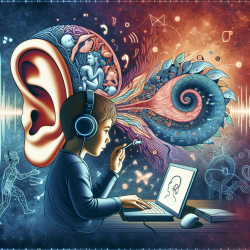Introduction
In the realm of speech-language pathology, the integration of vestibular hearing into therapeutic practices offers promising avenues for enhancing speech processing, particularly in challenging auditory environments. The research article "Vestibular Hearing and Speech Processing" provides critical insights into the relationship between vestibular hearing and speech recognition, emphasizing the potential for improved outcomes in noisy conditions. This blog aims to translate these findings into actionable strategies for practitioners, encouraging further exploration and application of vestibular hearing concepts in clinical settings.
Understanding Vestibular Hearing
Vestibular hearing is primarily evoked by the auditory sensitivity of the saccule to low-frequency, high-intensity sounds. This phenomenon is measured using cervical vestibular-evoked myogenic potentials (cVEMPs), which assess otolith function. The research highlights that individuals with secure vestibular hearing exhibit better word recognition scores in white noise (WRSs in wn), compared to those with vestibular impairments.
Key Findings
- Healthy individuals demonstrated detectable cVEMPs and higher WRSs in wn, averaging 66.9% in the right ear and 67.5% in the left ear.
- Dizzy patients with vestibular abnormalities showed decreased WRSs in wn, with scores of 51.4% in the right ear and 52.2% in the left ear.
- Significant differences in cVEMPs between affected and unaffected ears suggest that vestibular hearing enhances speech processing in noisy environments.
Implications for Practitioners
For speech-language pathologists, incorporating vestibular hearing assessments into practice can provide a more comprehensive understanding of a child's auditory processing capabilities. By identifying vestibular impairments, practitioners can tailor interventions to address specific challenges in speech recognition, particularly in noisy settings. This approach not only enhances therapeutic outcomes but also supports the development of robust auditory processing skills.
Encouraging Further Research
While the current research provides valuable insights, there is a need for further exploration into the mechanisms underlying vestibular hearing and its impact on speech processing. Practitioners are encouraged to engage in ongoing research and collaboration with audiologists to refine assessment techniques and intervention strategies. By staying informed about the latest developments in vestibular hearing research, practitioners can continue to optimize therapeutic outcomes for children.
Conclusion
Integrating vestibular hearing insights into speech-language pathology practice holds significant potential for improving speech processing in children, particularly in challenging auditory environments. By leveraging the findings from the research on vestibular hearing and speech processing, practitioners can enhance their skills and contribute to better outcomes for children. To delve deeper into the original research, please follow this link: Vestibular Hearing and Speech Processing.










